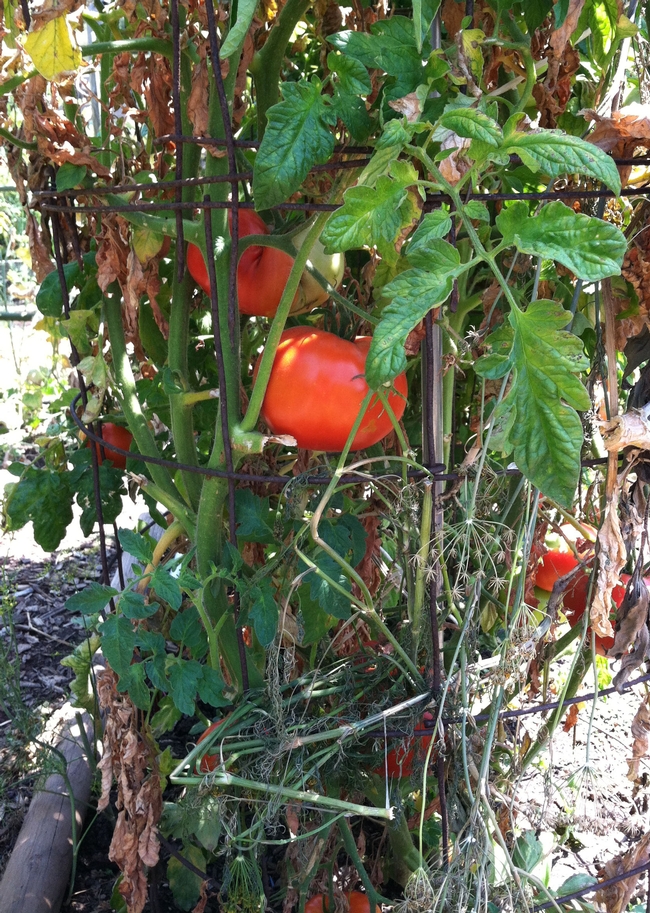Posts Tagged: Santa Clara
UCCE popularizes at-home composting in Santa Clara County
Composting Education Program helps repurpose waste, reduce methane emissions
Composting recycles organic matter such as leaves and food scraps into a valuable soil amendment. Vermicompost produced by worms offers numerous benefits for plants, such as boosting their growth and making them more resistant to disease and insects than plants grown with other composts or fertilizers. University of California Cooperative Extension in Santa Clara County is helping to make composting a go-to strategy for diverting household organic waste from landfills and supporting soil health.
Based at Martial Cottle Park in San Jose, UCCE's Composting Education Program is a volunteer-driven program that educates and supports Santa Clara County residents in composting. The project is funded by the Recycling and Waste Reduction Commission of Santa Clara County, the principal advisory body to councils and the Board of Supervisors on countywide solid waste planning issues, through the tipping fees collected by the county when garbage is hauled to waste processing facilities. By offering public education on organic waste diversion, the program is helping the county fulfill its SB 1383 requirements.
Master Composter volunteers trained by UCCE experts offer free compost workshops, K-12 school visits and table at community events to teach backyard and worm composting. On volunteer workdays, community members help to maintain the compost stations. In 2023, the program engaged nearly 5,000 students, residents and volunteers in educational activities.
Volunteer and Master Composter Jack Carter values the circular nature of the composting system, with materials going from kitchen to compost bin to worms to garden – and then back into the kitchen. He emphasized that composting is a simple way to boost soil health and something every resident can do.
“It takes organic material that we would throw away and makes amendments to build our soil up,” he said. “It's easy if we follow some simple rules and it's fun because you watch things change into what you can use. Easy-peasy – everyone can do it.”
Unique location provides unmatched opportunities
Martial Cottle Park contains the last farmland within the City of San Jose. Established by Edward Cottle in 1856 and continually maintained and farmed by his descendants until 2014, the land remained in agricultural production for over 150 years. The 287-acre site was then donated to provide a place where people in the community could learn about agriculture and celebrate the agricultural roots of the county.
“We have lots of hands-on opportunities for compost education, gardening and youth development here,” said Sheila Barry, UCCE county director in Santa Clara County.
The compost is used at the nearby UC Master Gardener demonstration garden and the adjacent open field – used for 4-H youth development animal husbandry projects – provides manure for the vermicomposting site. “Some of the youths are not so happy about how far they have to cart it,” she joked, “but it's incorporated into our really great compost product.”
Victoria Roberts, coordinator for the Composting Education Program, said the composting location comprises a variety of features.
“We've got a worm farm, backyard composting stations, and there's even a bicycle trommel that we're working on to sift finished compost,” she explained. “As you spin the bike, you're sifting the large chunks from the compost to make a fine, delicious earthy material that we get to use on our plants.”
The worm farm is maintained on the community volunteer workdays. “We're feeding the worms and giving them their habitat material with shredded newspaper,” said Roberts. “It's a way for us to recycle paper and help the worms live their most productive lives.”
Program helps community see ‘waste' as resource
UCCE Organic Materials Management Advisor Michael Cohen shared a broader view of the organic waste system and Cooperative Extension's work in this area. “The goal is to find valuable uses for what we call organic waste and see it not as waste, but as a resource,” he said.
He also noted other valuable uses of organic material beyond composting.
“One thing you can do with food waste instead of composting it is to dehydrate it – there are even industrial machines that dehydrate it and grind it into powder, which retains all that food energy that can be incorporated into the soil,” Cohen said. “And if you tarp the soil, you can generate an anaerobic environment where microbes consume the oxygen.”
Cohen is planning collaborative research with the Hansen Agricultural Research and Extension Center, UCCE Strawberry and Vegetable Crop Advisor Oleg Daugovish, and UCCE Specialist Joji Muramoto that will examine the use of vermicompost – in combination with steaming soil – to create a microbial community that suppresses Fusarium wilt in strawberries.
Cohen stressed the importance of diverting food waste from landfills to reduce methane emissions and to comply with Senate Bill 1383 that requires 75 percent of organic waste be diverted for other uses by 2025. “The Santa Clara County food waste diversion program is operating quite well in getting food- and yard waste-derived compost to farmers,” he said.
He also noted that proliferation of at-home composting through programs like theirs will help ease the environmental burdens of centralized composting, such as truck emissions and wear and tear on the roads. “There are many uses for organic materials at home – in your yard, in your potting soil, as a top dressing on your lawn,” he said. “You can even do vermicomposting on a small scale in an apartment.”
Growth suggests a promising future
Roberts, the program coordinator, is excited about the year ahead, noting that they will be “doing more hands-on workshops and demonstrations and reaching out to more schools.” She said that every city in the county works with the program on food-waste reduction educational initiatives.
“There's really nothing else like this place in the area, and we're continuing to grow,” Barry added. “We have a great corps of volunteers from our Master Gardener Program and our Composting Education Program, and our Youth Development Program is also growing. Youth in an urban area who would never have had an opportunity to interact with and raise an animal have that opportunity here.”
Any member of the community can volunteer to support the Composting Education Program, from feeding the worms to shredding paper or turning compost piles. There are also opportunities for residents to drop off kitchen and yard waste throughout the year. Learn more at https://cesantaclara.ucanr.edu/Home_Composting_Education.
Google features Santa Clara County 4-H member in new computer science video
A teen leader involved in the UC Cooperative Extension 4-H program in Santa Clara County was featured in a Google blog and video in honor of National Youth Science Day.
In an interview with the author, Curtis Ullerich, a Google employee and 4-H alum, Reyes said she joined 4-H at five years old, and worked on 4-H baking, flower arranging, poultry, sewing and guinea pig projects. She said she learned important life skills, like public speaking and organization. Last year, she took on a computer science project and now leads a computer science project for Santa Clara County youth.
"CS is a part of so many things," Reyes said. "... CS is part of fashion, agriculture, art, music and more."
Reyes became the first non-Googler to be featured in one of its CS First videos. "You're basically a celebrity now," Ullerich said.
In the video, Reyes and Olga, a CS First program manager at Google, introduce a free online activity called Animate a Name. Using an online tool, kids can choose any name - their own name, a school name, a club name, etc. - and make the letters change colors, spin or dance to a favorite tune.
"That was my first experience being professionally filmed and using a teleprompter, but it was very fun," Reyes said. "The final project turned out amazing. It's weird to think that kids all over the nation will be watching it as they do the Animate a Name activity."
Community gardens help stretch food dollars
This month Susan Algert, UC Cooperative Extension nutrition advisor, published research that shows gardeners can save money by growing their own vegetables.
“Low-income people in cities may be able to improve their nutrition by eating fresh vegetables grown in community gardens,” said Algert, who works with UC Cooperative Extension in Santa Clara, San Mateo and San Francisco counties.
To better understand how community gardens affect the affordability and amount of food available, she recruited 10 gardeners in San Jose to weigh the vegetables they harvested from their community gardens during the spring and summer.
The most common crops they grew were tomatoes, squash, green beans, peppers, onions, eggplants and cucumbers.
The citizen scientist gardeners harvested an average of 0.75 pounds of vegetables per square foot, which is more than the 0.60 pounds of vegetables per square foot USDA calculates as the typical harvest from conventional farming.
Algert found that community gardens produced on average 2.55 pounds of food per plant over the four months. For the season, buying the same vegetables at retail prices would have cost $435 more. People saved more money by growing more high-value crops such as tomatoes and peppers that grow vertically and occupy less ground space, she learned.
“We know that community gardens can be an important source of fruits and vegetables for people who don't live near a grocery store or a farmers market,” said Algert. “This study shows that vegetables from community gardens can also be more affordable than buying from a store. That's important to people who live on a low or fixed income.”
The amount of money people save by growing their own vegetables will vary. “Our citizen scientists who worked on this study are all experienced gardeners,” she said, “A novice gardener would likely need training to get the same results.”
Currently Algert is studying the amount of food grown in backyard gardens of low-income families in San Jose.
“It's a wonderful collaboration of nutrition educators, UC Cooperative Extension small farm advisors, UC Master Gardeners, Santa Clara University and Sacred Heart/Catholic Charities,” said Algert.
In addition to fresh produce, gardeners get some exercise. “Gardening is an excellent form of physical activity,” said Algert.
The study “Vegetable output and cost savings of community gardens in San Jose, California” is published in the July edition of the Journal of Academy of Nutrition and Dietetics at http://www.andjrnl.org.
The community garden study was conducted in collaboration with the City of San Jose's Parks, Recreation and Neighborhood Services Department, which manages 18 community gardens on 35 acres of land.








